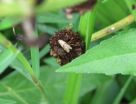(Press-News.org) A team of Iranian researchers from the Rice Research Institute of Iran have discovered that Gynnodomorpha permixtana, a well-known moth species from Europe and Asia, has changed its host preferences in order to adjust to Iran's northern region environmental conditions. The importance of this adaptation for biological control of problematic weeds in rice fields and the biology of the moth on new host plant have been described in the open access journal Nota Lepidopterologica.
The larvae of G. permixtana have been so far reported to feed on the seeds and flowers of plant species such as water-plantain, eyebright, lousewort, bitter root and European yellow-rattle, which are weeds commonly present across Europe and Asia. A new study of the populations in northern Iran, however has revealed a new host - Sagittaria trifolia, commonly known as arrowhead.
This new discovery suggests that climatic and environmental conditions in northern regions of Iran resulted in the choice of a new new host plant, and provides an exciting insight into how adaptation mechanisms work.
Arrowheads are groups of problematic perennial broadleaf weeds that thrive in rice fields and waterways. Favorable climatic condition after rice harvesting results in continued activity and thriving populations throughout the year.
The economic importance of this weed has prompted researchers from the Rice Research Institute of Iran to seek for possible solutions for the management of arrowhead. Their studies have revealed that the larvae of a certain moth species feeding on the fruits and seeds of the problematic weed, can lead to a dramatic decrease of its germination potential.
After this discovery the moth was sent for identification to Dr Leif Aarvik from the Natural History Museum, University of Oslo, who have diagnosed the species as the commonly known G. permixtana, which was in this case demonstrating a very uncommon host preference.
'To our surprise, it looks like this moth chose new host plant in Iran. This moth was reported in 2009 from the northern regions of the country, but its host plant was unknown. Its usual host plants, such as water-plantain, also grow in Iran but peculiarly we couldn't find its damage symptoms on them. That made this moth host range and biology in Iran rather mysterious at that point, and the recent discovery of arrowheads as its preferred host in the region brings even more peculiarity in the story.' commented the lead author of the study Atousa Farahpour Haghani a Phd student from, Rice Research Institute of Iran.
'Many factors can possibly influence host plant choice including food quality and quantity, climatic conditions, synchronization, physiological conditions in both insect and food plant, genetic modifications etc. Some of these factors are not stable and change in different environmental conditions, so an insect can change its choice of food plant on the basis of seeking the most beneficial complex of factors. It seems that in the northern regions of Iran, and luckily for rice crops, the problematic arrowheads present the best choice for G. permixtana.' added Haghani.
INFORMATION:
Original source:
Atousa Farahpour Haghani, Bijan Yaghoubi, Farzad Majidi-Shilsar, Naser Davatghar, Leif Aarvik. 2014. The biology of Gynnidomorpha permixtana (Lepidoptera, Tortricidae) on Sagittaria trifolia L. (Alismataceae) in paddy fields in Iran. Nota Lepidopterologica. 37(2): 113-121 | DOI 10.3897/nl.37.7708
Unusual host preference of a moth species could be useful for biological control
2014-09-11
ELSE PRESS RELEASES FROM THIS DATE:
Ebola paper demonstrates disease transmission rate
2014-09-11
Sept. 11, 2014 - New research from Arizona State University and the University of Tokyo that analyzes transmission rates of Ebola in West African countries shows how rapidly the disease is spreading.
Researchers Gerardo Chowell-Puente, ASU School of Human Evolution and Social Change Associate Professor, and Hiroshi Nishiura of the University of Tokyo found that transmission rates for each single case of Ebola consistently showed at least one new case of the disease being transmitted. Country-specific analysis of transmission rates in Liberia and Sierra Leone showed on ...
Some male scientists willing to forsake careers for family
2014-09-11
One third of men in academic science are willing to scale back their careers to focus on family life, according to researchers.
While traditional fatherhood roles may be shifting, men in the male-dominated field of academic science, such as physics and biology, face significant challenges in trying to balance work and family life, said Sarah Damaske, assistant professor of labor and employment relations and sociology, Penn State. The majority of men studied spoke of the pull of fatherhood and a desire to spend more time with children, yet they also acknowledged that academic ...
Not enough vitamin B1 can cause brain damage
2014-09-11
MAYWOOD, Ill – (Sept. 11, 2014) A deficiency of a single vitamin, B1 (thiamine), can cause a potentially fatal brain disorder called Wernicke encephalopathy.
Symptoms can include confusion, hallucinations, coma, loss of muscle coordination and vision problems such as double vision and involuntary eye movements. Untreated, the condition can lead to irreversible brain damage and death, according to neurologists at Loyola University Medical Center.
In the developed world, Wernicke encephalopathy typically occurs in people who have disorders such as alcoholism and anorexia ...
Investigators from Montefiore and Einstein to present data at 2014 ASTRO Meeting
2014-09-11
NEW YORK (September 10, 2014) – Members of the Department of Radiation Oncology at Montefiore Einstein Center for Cancer Care (MECCC) and Albert Einstein College of Medicine of Yeshiva University's NCI–designated Albert Einstein Cancer Center will present new study findings at the 56th Annual Meeting of the American Society for Radiation Oncology (ASTRO) revealing the impact socioeconomic status has on radiation treatment compliance, predictive indicators for clinical outcomes and on radiation therapy duration and dosing recommendations. ASTRO is being held September 14 ...
Two new species of carabid beetles found in Ethiopia
2014-09-11
There are more than 150 species of beetles in the genus Calathus, 17 of which have only been found in the mountains of the Ethiopian Highlands. Now scientists have found two new ones — Calathus juan and Calathus carballalae — and have described them in Annals of the Entomological Society of America.
C. juan is named for Juan Novoa, the son of one of the authors, in recognition of his help on various beetle-collecting expeditions. Adults are black and shiny, and are 9.5-11.5 millimeters long. It was found under stones at the base of giant, tree-like plants called lobelias ...
How salt causes buildings to crumble
2014-09-11
This news release is available in German. Historic stone buildings are tourist magnets. The Jordanian rock city of Petra, the medieval town of Rhodes in the Aegean Sea and the sandstone temples at Luxor, Egypt, for example, attract hundreds of thousands of visitors each year. These cultural assets all have one thing in common: they suffer from weathering caused by salts. These crystallise inside the porous building materials and generate enough force for the stone to break or crumble. The same problem also occurs in concrete buildings in this country.
Researchers at ...
Ticks that vector Lyme disease move west into North Dakota
2014-09-11
According to the U.S. Centers for Disease Control, there are more than 300,000 cases of Lyme disease in the U.S. each year. Last year, most Lyme disease cases reported to the CDC were concentrated heavily in the Northeast and upper Midwest, with 96 percent of cases in 13 states. In fact, the disease gets its name from the northeastern town of Lyme, Connecticut, where it was first discovered.
However, a new article published in the Journal of Medical Entomology reports that the ticks that vector Lyme disease — Ixodes scapularis, also known as blacklegged ticks or deer ...
Increased access to nature trails could decrease youth obesity rates, MU study finds
2014-09-11
VIDEO:
Researchers at the University of Missouri and the University of Minnesota have found that local governments can help reduce youth obesity levels by increasing the amount and type of public...
Click here for more information.
COLUMBIA, Mo. – As youth obesity levels in America remain at record high levels, health professionals and policymakers continue to search for solutions to this national health issue. Now, researchers at the University of Missouri and the University ...
Study finds high protein diets lead to lower blood pressure
2014-09-11
(Boston)--Adults who consume a high-protein diet may be at a lower risk for developing high blood pressure (HBP). The study, published in the American Journal of Hypertension, by researchers from Boston University School of Medicine (BUSM), found participants consuming the highest amount of protein (an average of 100 g protein/day) had a 40 percent lower risk of having high blood pressure compared to the lowest intake level.
One of three U.S. adults has hypertension and 78.6 million are clinically obese, a risk factor for the development of hypertension. Because of the ...
New defense mechanism against viruses discovered
2014-09-11
This news release is available in German. When it comes to defence against viruses, the immune system has an arsenal of weapons at its disposal including killer cells, antibodies and messenger molecules, to name just a few. When a pathogen attacks the body, the immune system usually activates the appropriate mechanisms. However, some of the mechanisms do not have to be triggered; they are continuously active as a standing army. Researchers from ETH Zurich, in collaboration with scientists from the University of Bern, have now discovered a new form of this so-called ...



